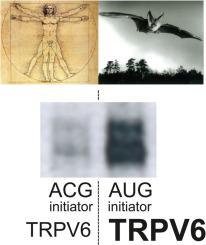Cell Calcium ( IF 4.3 ) Pub Date : 2020-10-06 , DOI: 10.1016/j.ceca.2020.102302 Karin Wolske 1 , Claudia Fecher-Trost 1 , Christine Wesely 1 , Heidi Löhr 1 , Stephan Philipp 1 , Anouar Belkacemi 1 , George Pacheco 2 , Ulrich Wissenbach 1

|
TRPV6 is a calcium selective TRP channel and is expressed in many species. TRPV6 transcripts are abundantly expressed in few tissues but strangely channel properties are only accessible to electrophysiological recordings after overexpression whereas in native tissue functional channel currents seem not to be detectable. Another exceptional property of human and mouse TRPV6 proteins is that the initiation of translation starts from a non-canonical ACG triplet which is translated as methionine. This triplet is located 120 bp upstream of the first in-frame AUG codon of the human/mouse TRPV6 mRNA. In contrast, the TRPV6 gene of bats is initiated from an AUG triplet at the corresponding position of the human ACG. On the basis of these structural nucleotide differences between human and bats we studied the role of the absolute N-Terminus for the regulation of translation by developing chimera and mutants of human/bat TRPV6 channels. The human sequence which is located downstream of the initiation codon slows down ribosomal scanning in 3′ direction. We suggest that the mechanism involves most likely the deceleration of ribosome scanning by stem-loop formation and the use of the common initiator tRNA, tRNAiMet, which is placed onto the inappropriate ACG codon resulting in low protein synthesis. The reduced translation efficiency is important to protect TRPV6 expressing cells from toxic calcium overload. The regulation of the TRPV6 translation in bats may be an adaptation to low calcium amounts present in the natural nutrition. In addition, we show that also the GFP protein can be controlled using the translational mechanism of human TRPV6.
中文翻译:

为什么无法检测到内源性 TRPV6 电流——我们可以从蝙蝠身上学到什么?
TRPV6 是一种钙选择性 TRP 通道,在许多物种中都有表达。TRPV6 转录本在少数组织中大量表达,但奇怪的是,通道特性仅在过表达后才能用于电生理记录,而在天然组织中,功能通道电流似乎无法检测到。人和小鼠 TRPV6 蛋白的另一个特殊特性是翻译起始于非规范 ACG 三联体,该三联体被翻译为甲硫氨酸。该三联体位于人/小鼠 TRPV6 mRNA 的第一个框内 AUG 密码子上游 120 bp。相比之下,蝙蝠的 TRPV6 基因是从人类 ACG 相应位置的 AUG 三联体开始的。基于人类和蝙蝠之间的这些结构核苷酸差异,我们通过开发人类/蝙蝠 TRPV6 通道的嵌合体和突变体,研究了绝对 N 端在调节翻译中的作用。位于起始密码子下游的人类序列减慢了 3' 方向的核糖体扫描。我们认为该机制很可能涉及通过茎环形成和使用共同的起始 tRNA tRNA 来减慢核糖体扫描i Met,它被放置在不合适的 ACG 密码子上,导致蛋白质合成率低。降低的翻译效率对于保护表达 TRPV6 的细胞免受有毒钙超载很重要。蝙蝠中 TRPV6 翻译的调节可能是对天然营养中存在的低钙量的适应。此外,我们表明也可以使用人类 TRPV6 的翻译机制来控制 GFP 蛋白。











































 京公网安备 11010802027423号
京公网安备 11010802027423号